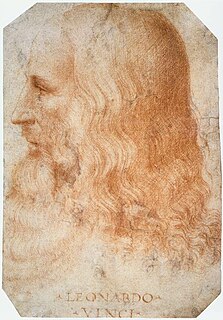
Leonardo di ser Piero da Vinci, more commonly Leonardo da Vinci or simply Leonardo, was an Italian polymath of the Renaissance whose areas of interest included invention, drawing, painting, sculpting, architecture, science, music, mathematics, engineering, literature, anatomy, geology, astronomy, botany, writing, history, and cartography. He has been variously called the father of palaeontology, ichnology, and architecture, and he is widely considered one of the greatest painters of all time. Sometimes credited with the inventions of the parachute, helicopter, and tank, he epitomised the Renaissance humanist ideal.
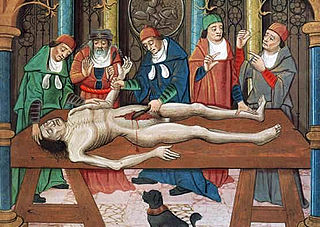
The history of anatomy extends from the earliest examinations of sacrificial victims to the sophisticated analyses of the body performed by modern scientists. The study of human anatomy can be traced back thousands of years, at least to the Egyptians, but the science of anatomy, as we know it today, did not develop until far later. The development of the study of anatomy gradually built upon concepts that were understood during the time of Galen and slowly became a part of the traditional medical curriculum. It has been characterized, over time, by a continually developing understanding of the functions of organs and structures in the body.

Sfumato is a painting technique for softening the transition between colours, mimicking an area beyond what the human eye is focusing on, or the out-of-focus plane. Leonardo da Vinci was the most prominent practitioner of sfumato, based on his research in optics and human vision, and his experimentation with the camera obscura. He used it in many works, including the Virgin of the Rocks and in his famous painting of the Mona Lisa. He described sfumato as "without lines or borders, in the manner of smoke or beyond the focus plane".

The Codex Leicester is a collection of scientific writings by Leonardo da Vinci. The Codex is named after Thomas Coke, later created Earl of Leicester, who purchased it in 1719. The manuscript currently holds the record for the second highest sale price of any book, as it was sold to Bill Gates at Christie's auction house on 11 November 1994 in New York for US$30,802,500.

The Vitruvian Man, or simply L'Uomo Vitruviano, is a drawing made by the Italian polymath Leonardo da Vinci around 1490. It is accompanied by notes based on the work of the architect Vitruvius. The drawing, which is in ink on paper, depicts a man in two superimposed positions with his arms and legs apart and inscribed in a circle and square. The drawing and text are sometimes called the Canon of Proportions or, less often, Proportions of Man. It is kept in the Gabinetto dei disegni e stampe of the Gallerie dell'Accademia, in Venice, Italy, under reference 228. Like most works on paper, it is displayed to the public only occasionally, so it is not part of the normal exhibition of the museum.

Leonardo's robot, or Leonardo's mechanical knight, was a humanoid automaton designed and possibly constructed by Leonardo da Vinci around the year 1495.

Annunciation is a painting by the Italian Renaissance artists Leonardo da Vinci and Andrea del Verrocchio, dating from circa 1472–1475. It is housed in the Uffizi gallery of Florence, Italy.
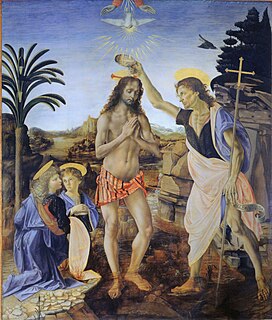
The Baptism of Christ is a painting finished around 1475 in the studio of the Italian Renaissance painter Andrea del Verrocchio and generally ascribed to him and his pupil Leonardo da Vinci. Some art historians discern the hands of other members of Verrocchio's workshop in the painting as well.

Martin Kemp is emeritus professor of the history of art at University of Oxford. He is considered one of the world's leading experts on the art of Leonardo da Vinci and visualisation in art and science.

The personal life of Leonardo da Vinci has been a subject of interest, inquiry, and speculation since the years immediately following his death. Leonardo has long been regarded as the archetypal Renaissance man, described by the Renaissance biographer Giorgio Vasari as having qualities that "transcended nature" and being "marvellously endowed with beauty, grace and talent in abundance". Interest in and curiosity about Leonardo has continued unabated for five hundred years. Modern descriptions and analysis of Leonardo's character, personal desires and intimate behavior have been based upon various sources: records concerning him, his biographies, his own written journals, his paintings, his drawings, his associates, and commentaries that were made concerning him by contemporaries.

Leonardo da Vinci (1452–1519) was an Italian polymath, regarded as the epitome of the "Renaissance Man", displaying skills in numerous diverse areas of study. Whilst most famous for his paintings such as the Mona Lisa and the Last Supper, Leonardo is also renowned in the fields of civil engineering, chemistry, geology, geometry, hydrodynamics, mathematics, mechanical engineering, optics, physics, pyrotechnics, and zoology.

An écorché is a figure drawn, painted, or sculpted showing the muscles of the body without skin, normally as a figure study for another work or as an exercise for a student artist. The Renaissance-era architect, theorist and all-around Renaissance man, Leon Battista Alberti, recommended that when painters intend to depict a nude, they should first arrange the muscles and bones, then depict the overlying skin.
A cadaver is a dead human body that is used by medical students, physicians and other scientists to study anatomy, identify disease sites, determine causes of death, and provide tissue to repair a defect in a living human being. Students in medical school study and dissect cadavers as a part of their education. Others who study cadavers include archaeologists and artists.

The Medical Renaissance, from 1400 to 1700 CE, is the period of progress in European medical knowledge, and a renewed interest in the ideas of the ancient Greeks and Romans. Such medical discoveries during the Medical Renaissance are credited with paving the way for modern medicine.
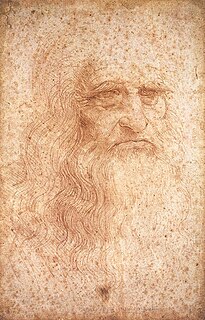
The portrait of a man in red chalk in the Biblioteca Reale, Turin is widely, though not universally, accepted as a self portrait of Leonardo da Vinci. It is thought that Leonardo da Vinci drew this self-portrait at about the age of 60. The portrait has been extensively reproduced and has become an iconic representation of Leonardo as a polymath or "Renaissance Man". Despite this, some historians and scholars disagree as to the true identity of the sitter.

Gian Giacomo Caprotti da Oreno, better known as Salaì, was an Italian artist and pupil of Leonardo da Vinci from 1490 to 1518. Salaì entered Leonardo's household at the age of ten. He created paintings under the name of Andrea Salaì. He was described as one of Leonardo's students and lifelong servant and is thought by some to be the model for Leonardo's St. John the Baptist and Bacchus.

Carlo Pedretti was an Italian historian. His area of expertise was the life and works of Leonardo da Vinci. He was a professor of art history and Armand Hammer Chair in Leonardo Studies at the University of California, Los Angeles from 1960 until his retirement in 1993.
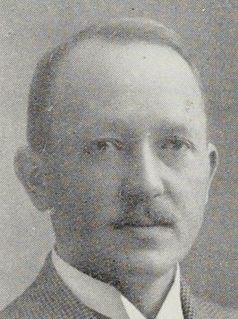
Adolf Mauritz Fonahn was a Norwegian physician, medical historian and orientalist. He is best known for his work including those revolving around Tibetan Buddhism, Leonardo da Vinci's anatomical drawings, early Persian and Arabic medical literature, and more generally the study of medical history and Asian languages.

Studies of the Fetus in the Womb are two colored annotated sketches by Leonardo da Vinci made in around 1511. The studies correctly depict the human fetus in its proper position inside a dissected uterus. Da Vinci depicted the uterus with one chamber, in contrast to theories that the uterus had multiple chambers which many believed divided fetuses into separate compartments in the case of twins. Da Vinci also correctly drew the uterine artery and the vascular system of the cervix and vagina.


















